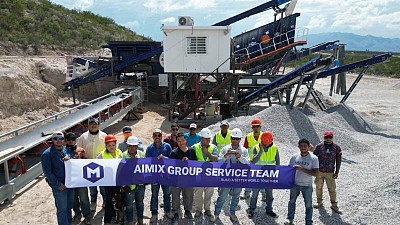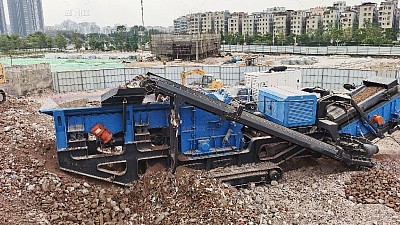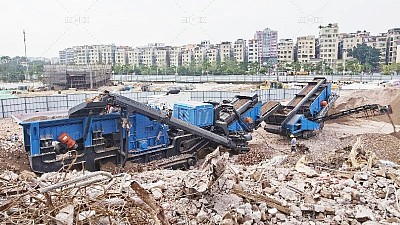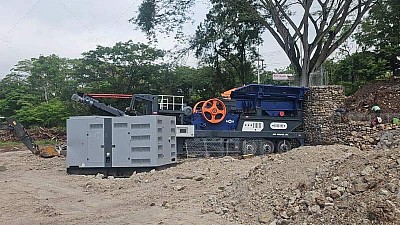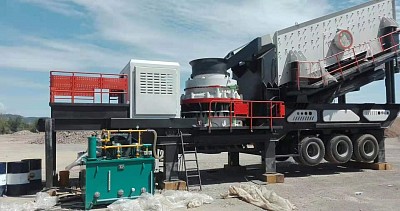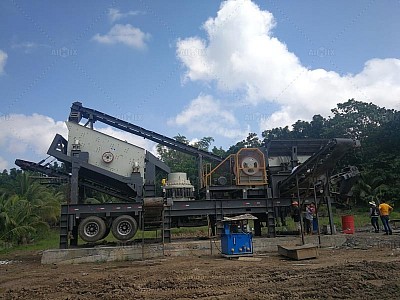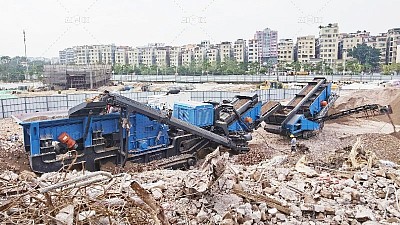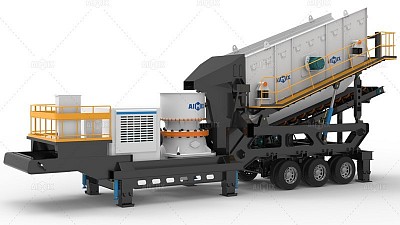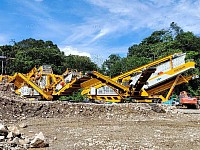Stone Crusher Machines
How to Achieve Efficient Crushing and Screening in Mining Areas with Complex Topography
Mining operations in areas with rugged terrain and challenging topography face unique obstacles. Steep slopes, uneven ground, and limited access roads can make traditional stationary crushing and screening setups inefficient or even unfeasible. To address these challenges, many mining companies are turning to mobile and compact solutions that can adapt to complex environments without sacrificing productivity. Equipment such as mobile stone crushers(trituradora movil de piedra), jaw crushers, and mini stone crushers has proven essential in optimizing operations while reducing costs and downtime.
Challenges of Mining in Complex Topography
Mining in mountainous or hilly regions comes with logistical and operational difficulties. Transportation of raw materials from extraction points to processing sites can be slow and costly due to limited road access and difficult terrain. Additionally, conventional stationary crushing equipment often requires extensive site preparation, including leveling, foundations, and heavy transport infrastructure.
Environmental concerns also play a role. Excessive road building or earthworks can lead to soil erosion, water runoff issues, and disruption of local ecosystems. As a result, mining operators need flexible and mobile solutions that can work efficiently within the natural contours of the landscape.
Mobile Stone Crushers: Flexibility and Mobility
Advantages for Rugged Mining Sites
A mobile stone crusher is designed to be easily transported and operated directly at the mining site. Its mobility allows operators to move the unit closer to raw material sources, reducing the need for long hauling distances. This feature is particularly valuable in regions where road networks are limited or temporary.
Mobile crushers often integrate multiple functions, including crushing, screening, and material sorting, into a single unit. This reduces the number of machines needed on-site and streamlines the workflow. For mining areas with complex topography, this means less site preparation, faster setup, and minimized environmental impact.
Enhancing Productivity
By processing materials near the extraction points, mobile stone crushers allow for continuous operation without the interruptions caused by material transport. The machines can handle large quantities of stone, gravel, and other mined materials, improving overall output while reducing energy consumption and labor costs.
Jaw Crushers for Primary Crushing
High Efficiency and Reliability
Jaw crushers are widely used for primary crushing in mining operations. They are capable of handling hard, abrasive rocks while providing uniform output size. In mining areas with steep gradients or uneven terrain, jaw crushers(trituradora de mandíbula características) can be combined with mobile platforms to maintain consistent production even in challenging environments.
The robust design of jaw crushers ensures durability and long service life, even under demanding conditions. Additionally, adjustable settings allow operators to control the size of the output material, which is essential for downstream processes such as screening or secondary crushing.
Integration with Mobile Systems
Jaw crushers are often installed on mobile or semi-mobile chassis, allowing them to be relocated as mining progresses. This flexibility is crucial in complex topographies, where a fixed crusher may not be feasible or cost-effective. By pairing a jaw crusher with a mobile stone crusher, mining operators can achieve a full crushing workflow that adapts to the contours and constraints of the site.
Mini Stone Crushers: Compact Solutions for Limited Space
Ideal for Small or Remote Sites
In addition to full-sized mobile crushers, mini stone crushers(mini trituradora de piedra) provide a compact solution for small-scale operations or areas with very limited space. These machines are lightweight, easy to transport, and capable of handling smaller volumes of material efficiently.
Mini stone crushers are particularly useful in remote mining sites where moving larger machinery would be impractical. They allow operators to start processing materials quickly, even in areas where road access is restricted or terrain is highly uneven.
Flexibility and Cost-Effectiveness
Mini stone crushers offer a lower initial investment and reduced operating costs compared to larger units. For smaller mining projects or exploratory operations, these machines provide an affordable entry point without compromising efficiency. Despite their size, modern mini crushers often include advanced features such as adjustable output sizes, vibration feeders, and integrated screening options.
Strategies for Efficient Crushing and Screening
Site Assessment and Equipment Selection
To maximize efficiency in complex topographies, thorough site assessment is critical. Understanding the terrain, material characteristics, and project scale helps determine the optimal combination of mobile stone crusher, jaw crusher, and mini stone crusher units. Selecting the right equipment ensures that crushing and screening operations are both productive and cost-effective.
Integrated Crushing and Screening Systems
Combining crushing and screening into a single workflow reduces handling times and energy consumption. Mobile units with integrated screening belts and conveyors can separate materials immediately after crushing, producing ready-to-use aggregates on-site. This minimizes the need for additional transport or stockpiling.
Regular Maintenance and Monitoring
Operating in rough terrain can place extra stress on machinery. Regular maintenance, timely replacement of wear parts, and monitoring of key performance indicators help ensure consistent output and prolong equipment life. Modern mobile crushers often include digital monitoring systems to track performance, detect faults early, and optimize operational efficiency.
Conclusion
Mining in areas with complex topography requires adaptive and flexible equipment solutions. Mobile stone crushers, jaw crushers, and mini stone crushers provide the mobility, efficiency, and reliability needed to overcome challenges posed by steep, uneven, or remote sites.
By selecting the right combination of equipment, integrating crushing and screening workflows, and maintaining machines proactively, mining operators can achieve high productivity, reduce costs, and minimize environmental impact. These strategies enable sustainable and efficient operations, even in the most challenging mining landscapes.
Why Does the Price of Mobile Stone Crushers Vary from Region to Region?
Mobile stone crushers have become essential in modern aggregate production, especially in remote or fast-changing construction sites. However, many buyers notice that prices can differ significantly depending on the region. What causes this variation? Understanding the regional factors can help businesses make smarter purchasing decisions and plan their budgets more effectively.
In this article, we’ll explore the key reasons behind regional price differences for mobile stone crusher plants(planta trituradora de piedra movil). Whether you are working on an infrastructure project or operating an aggregate crusher plant, knowing these factors will guide your investment strategy.
Cost of Raw Materials and Local Manufacturing
One of the most direct influences on the cost of a mobile stone crusher plant is the local availability of raw materials like steel, rubber, and electronics. In countries with strong mining and steel production industries, the cost of producing the machinery is naturally lower. For instance, manufacturers in China or India may offer lower prices due to economies of scale and abundant resources.
Meanwhile, in regions where materials must be imported, like some African or Latin American countries, the production or importation cost rises, which is reflected in the final price of the stone crusher plant(planta trituradora de piedra).
Transportation and Logistics Expenses
Transportation is a major cost factor when purchasing heavy machinery. Mobile stone crushers are not small; even a compact unit may require special trucks, permits, or even disassembly and reassembly. If you are purchasing a unit from overseas or transporting it inland in a country with limited infrastructure, the freight cost can add significantly to the total price.
For example, a mobile unit that is affordable at the factory gate in Southeast Asia could become much more expensive once delivered to a remote project site in Sub-Saharan Africa or South America. Choosing a supplier with experience in exporting complete crushing lines to your region can reduce unexpected costs.
Import Duties and Taxes
Import regulations and tariffs can vary greatly by region. Some governments encourage local equipment production by imposing high taxes on imported machinery, especially in developing countries trying to grow their manufacturing sectors. These duties can inflate the price of a mobile stone and aggregate crusher plant(planta de agregados) by 10% to 30% or more.
In contrast, in regions where free trade agreements or tax exemptions apply, the same equipment may be significantly more affordable. It's crucial for buyers to check their country’s customs policies before finalizing any purchase.
Demand and Competition in the Market
The level of market competition in a region also plays a major role. In highly competitive markets, such as the Middle East or Southeast Asia, there are often many suppliers offering similar models. This competition helps keep prices low.
However, in less saturated markets, there may be only a few authorized dealers or suppliers. Limited options often allow sellers to maintain higher prices, especially if their mobile or portable concrete plant and crushing equipment are in high demand for infrastructure or mining projects.
After-Sales Service and Spare Parts Support
Some regions offer better access to after-sales service, spare parts, and technical support. A stone crusher plant might be cheaper in one region, but if spare parts are unavailable or service takes weeks, that lower price could result in higher long-term costs due to downtime.
Suppliers with a strong regional presence or partnerships with local agents can provide better support, and while their machines might seem more expensive initially, the total cost of ownership is often lower in the long run.
Type of Equipment and Customization Needs
Lastly, the price also depends on what features or configurations are needed in a particular region. For example, a customer in a mountainous area might need a more mobile or skid-mounted unit, while another in an urban area might require quieter, more compact machines. Customization and upgrades—such as dust suppression systems or advanced automation—can vary by market demand and significantly impact the price.
Some regions prefer large-scale solutions like a complete aggregate crusher plant, while others rely on modular or mini crusher units due to limited space and project size.
Conclusion
In summary, the price of a mobile stone crusher plant depends on more than just the base model—it is shaped by the region’s raw material costs, logistics, import policies, competition, service availability, and buyer preferences. Whether you're investing in a stone crusher plant or expanding an aggregate crusher plant operation, evaluating these factors regionally will help you make a cost-effective and strategic decision.
If you're considering a mobile crusher for your next project, consult suppliers with export experience and a strong understanding of regional market conditions to get the best value and long-term support.
From Automation to Remote Support, Why Latin America Chooses Smart Mobile Crushers
The demand for modern, efficient, and flexible crushing solutions is accelerating across Latin America. Whether it’s quarrying, infrastructure construction, or mining, operators are no longer just looking for machines that can crush rock—they want smart machines that reduce downtime, improve output quality, and adapt to changing site conditions. That’s where the new generation of intelligent mobile stone crusher units is making a significant impact.
This article explores why smart features like automation, digital monitoring, and remote technical support are influencing purchasing decisions in Latin America—and how equipment like the jaw crusher and limestone crusher is evolving to meet these expectations.
The Evolution of Crushing in Latin America
From Manual to Automated Operation
In the past, many crushing operations in Latin America relied on manual control and constant operator supervision. But this approach often led to inefficient fuel use, inconsistent output sizes, and increased risk of human error. Today’s smart mobile stone crusher(vendo trituradora de piedra móvil) systems offer automated startup sequences, self-adjusting settings, and integrated sensors that reduce the need for direct human control.
These automation features ensure that crushers run at optimal efficiency with minimal oversight—especially useful for projects where skilled labor is scarce or where multiple machines need to be operated at once.
Increased Emphasis on Output Precision
As the region’s construction standards continue to rise, so does the demand for high-quality aggregates with precise size gradation. Intelligent crushers now come with real-time adjustment systems that maintain consistent output, even as material properties fluctuate throughout the day. Whether it's a jaw crusher processing hard granite or a limestone crusher(trituradora de piedra caliza) producing fine aggregates, automation enables real-time adjustments to the feed rate, CSS (closed side setting), and screen integration—ensuring product consistency with every load.
Key Smart Features That Are Driving Adoption
Remote Monitoring and Diagnostics
In countries like Mexico, Peru, and Brazil, job sites are often located far from service centers. To minimize downtime, modern mobile stone crusher units are now equipped with remote monitoring systems that allow technicians to:
- Access performance data from anywhere
- Identify issues before they escalate
- Provide software updates or troubleshooting assistance in real time
With GSM, Wi-Fi, or satellite connections, operators can get real-time alerts for fuel efficiency, bearing temperature, hydraulic pressure, and more. This capability is especially valuable in Latin America, where distances between quarries and maintenance hubs can stretch hundreds of kilometers.
Integration With Fleet Management Systems
Smart crushers can now be integrated into broader fleet management platforms, enabling site managers to view all mobile units, loaders, and excavators in one dashboard. This enhances coordination and resource allocation across multiple crushing zones.
For operations with multiple limestone crusher or jaw crusher(mandibula trituradora de piedra) units running simultaneously, centralized monitoring reduces duplication of effort and improves throughput planning.
Applications in the Latin American Market
Mining and Quarrying Operations
In remote mining operations in Chile or Colombia, smart crushers help reduce the need for on-site service teams. Instead of flying technicians in for each issue, operators can remotely diagnose problems and implement fixes faster—saving time and costs while reducing machine downtime.
Moreover, automation ensures stable production levels despite fluctuating ore characteristics or unpredictable weather conditions.
Infrastructure Projects in Urban and Rural Zones
For urban projects such as bridge construction or airport expansion, precise output and noise control are critical. Smart mobile stone crusher units equipped with data-driven control systems can operate within strict environmental parameters while delivering material on time.
In rural zones, mobile units with smart features can be rapidly deployed to temporary sites, run autonomously with limited staff, and be easily relocated once the job is done—ideal for road development and municipal upgrades.
The Role of Training and After-Sales Support
Latin American contractors are becoming increasingly aware that technology alone isn’t enough—it needs to be supported by accessible training and after-sales service. Manufacturers offering remote training, digital manuals, and 24/7 support hotlines are gaining customer trust and loyalty.
Buyers are also favoring brands that offer bilingual interfaces and region-specific technical support for their smart systems. This helps bridge the gap between advanced features and local workforce capabilities.
Conclusion
Smart crushing technology is no longer just a premium feature—it’s quickly becoming a necessity across Latin America’s aggregate and mining sectors. Whether through automated controls, remote diagnostics, or integrated fleet systems, intelligent mobile stone crusher equipment is helping contractors reduce costs, maximize uptime, and adapt to diverse site conditions.
As demand rises for higher productivity and lower operational risk, equipment like the jaw crusher and limestone crusher will continue to evolve—powered by smart features that put control, insight, and efficiency right at the operator’s fingertips.
Crusher Test Process: Ensuring the Efficient Operation of Each Mobile Stone Crusher
In the mining and aggregate industries, ensuring the efficient operation of equipment is essential to maintain productivity and reduce operational costs. Mobile stone crushers play a crucial role in this process, and their performance must be tested before full-scale operation. By running a comprehensive test process, manufacturers and operators can confirm that each machine—whether it's a jaw crusher, an impact crusher, or other types of crushers—performs at optimal efficiency under real-world conditions.
In this article, we’ll explore the key steps in the crusher test process and why it is so important for the efficiency and longevity of mobile stone crushers(vendo trituradora de piedra móvil).
The Importance of the Crusher Test Process
The crusher test process is an essential phase in the commissioning of any mobile stone crusher. The goal of the test process is to evaluate the machine’s performance, identify any operational issues, and fine-tune the settings to ensure that the crusher functions efficiently throughout its service life.
Before any jaw crusher or impact crusher begins full-scale operations at a mining or construction site, it’s critical to verify that all components are working as they should. Proper testing reduces the risk of breakdowns, ensures that the equipment meets safety standards, and helps optimize the machine for specific material types and operating conditions.
1. Visual and Mechanical Inspection
The first step in the testing process is a thorough visual and mechanical inspection of the mobile stone crusher. This inspection ensures that all parts are correctly assembled, and any potential mechanical issues are identified before the crusher is powered on.
Components such as the chassis, bearings, motors, and crushers (whether a jaw crusher(trituradora de muelas) or an impact crusher) are checked for alignment, fit, and signs of damage or wear. Special attention is given to the moving parts, as these are subject to the most stress during operation. Ensuring these parts are properly lubricated and functioning will minimize the risk of friction and overheating during later stages of the test.
2. Operational Test Run
Once the visual and mechanical checks are complete, the next phase of the testing involves running the mobile stone crusher at low capacity. During this stage, the operator monitors the crusher to ensure that all parts are working correctly and efficiently.
For example, during the test run of a jaw crusher, the operator observes the performance of the crushing action, checking the uniformity of the crushed material and ensuring the crusher is delivering the desired size reduction. Similarly, when testing an impact crusher, the operator examines the impact force and the rate at which the material is broken down.
The test run also includes assessing the operation of the conveyors, feed hoppers, and other connected systems. If any components show signs of malfunction, adjustments are made before proceeding to the next phase of testing.
3. Performance Evaluation
After completing the initial test run, the mobile stone crusher is evaluated for its overall performance. This step involves measuring key parameters such as throughput, power consumption, and product size.
For a jaw crusher, the efficiency of material size reduction is measured. The goal is to determine if the crusher is meeting the target output size and whether the machine is operating within its ideal crushing range. An impact crusher(chancadora de impacto), on the other hand, is evaluated for its ability to break down materials at the desired rate without causing excessive wear on its components.
The performance evaluation helps identify any inefficiencies in the machine’s operation, such as excessive fuel consumption or material loss, which could lead to higher operating costs. Based on these results, adjustments can be made to optimize the performance of the crusher.
4. Safety and Control System Checks
During the test process, it’s essential to ensure that all safety systems are functioning correctly. Crushers are equipped with a variety of safety features, including emergency stop buttons, overload protection, and alarms for overheating or low oil levels.
The control system also undergoes thorough testing to verify that it operates correctly. This includes testing the crusher’s automation systems, remote control capabilities, and data logging features. The goal is to ensure that the machine can be operated safely and efficiently under various operating conditions.
Testing the safety and control systems ensures that the mobile stone crusher complies with relevant safety standards and provides operators with the tools to manage the machine effectively.
5. Load and Stress Testing
Once the machine has passed the initial operational and safety checks, it undergoes load and stress testing to simulate the conditions it will experience during full-scale operation. This testing helps assess how the mobile stone crusher performs under heavy load conditions, such as when it is crushing high volumes of tough materials.
During load testing, the machine is subjected to its maximum capacity to see if it can handle the stress without overloading or malfunctioning. This phase is critical in identifying any potential weaknesses in the crusher's design or construction. If issues arise during the load testing phase, they can be addressed before the crusher begins full-scale production.
6. Final Adjustments and Calibration
The final step in the crusher test process involves making any necessary adjustments based on the results of the performance and load testing. This could involve fine-tuning the crusher’s settings to optimize its performance for specific material types or adjusting operational parameters to improve efficiency.
For instance, the settings on the jaw crusher may need to be adjusted to accommodate different sizes of input material. Similarly, the rotor speed of an impact crusher might be modified to achieve the desired reduction ratio. Once these final adjustments are made, the crusher is ready for regular operations.
Conclusion
The crusher test process is a crucial step in ensuring the efficient operation and longevity of mobile stone crushers. By conducting thorough tests—ranging from visual inspections to performance evaluations and load testing—operators can identify any issues before they lead to costly downtime or equipment failure. Whether it’s a jaw crusher, impact crusher, or another type of crusher, a detailed test process is essential for maximizing efficiency and ensuring reliable performance in the field.
With proper testing, mobile stone crushers can deliver optimal results, contributing to smoother mining operations and improved productivity.
Why Streamlined Crushing Processes Matter in Mobile Crusher Plants
In the mining and aggregates industry, the efficiency of a mobile stone crusher plant plays a crucial role in meeting production targets and reducing operational costs. One key factor in achieving high efficiency is a streamlined crushing process. A streamlined process means that every stage, from crushing to screening, works smoothly and with minimal interruptions. This approach is essential for maximizing throughput and maintaining consistent product quality in aggregate production.
A well-designed stone crusher system eliminates bottlenecks, reduces maintenance downtime, and ensures that materials are processed quickly and effectively. Whether you're working with a small stone crusher for more localized operations or a large mobile plant for high-volume tasks, streamlining the crushing process can significantly enhance productivity and profitability.
The Importance of Streamlined Crushing in Mobile Crusher Plants
The crushing process in mobile crusher plants(planta de trituracion movil) typically involves multiple stages, including primary, secondary, and sometimes tertiary crushing, followed by screening. Each stage must be carefully managed to ensure that it operates at optimal efficiency. When the stages are not properly integrated or if one part of the process becomes a bottleneck, it can lead to reduced efficiency, increased wear on machinery, and higher operational costs.
For mobile crushing plants, especially those used in the stone crusher industry, streamlining each phase of crushing ensures that the plant operates smoothly and continues to produce high-quality aggregates at a steady rate. A streamlined system is not only about speed—it’s also about maintaining consistency and precision throughout the process.
1. Reduced Downtime and Increased Efficiency
One of the key benefits of a streamlined crushing process is reduced downtime. In a mobile stone crusher plant, equipment breakdowns or delays in one part of the process can have a domino effect, causing delays throughout the entire operation. If the crushers aren’t properly maintained or if there's a lack of coordination between the various stages, it can take longer to process materials, increasing the risk of production halts.
By streamlining the crushing process, operators can ensure that each stage flows seamlessly into the next. For instance, using integrated crushing and screening equipment minimizes the need to move material between different units, reducing transport time and ensuring quicker throughput. This is especially important when working with a small stone crusher(mini chancadora de piedra), where space and time are often limited.
2. Better Resource Utilization
When crushing processes are streamlined, the plant can make better use of its resources—especially energy and labor. A well-optimized system requires less power to achieve the same results, which can significantly lower operating costs. Additionally, less energy is wasted on unproductive tasks such as moving materials back and forth between crushers and screens.
Streamlining the process also means that fewer personnel are needed for tasks like monitoring, setup, and maintenance, which reduces labor costs. With a mobile stone crusher plant, operators can achieve higher efficiency without sacrificing the quality of the output, resulting in increased profitability.
3. Enhanced Material Flow
Efficient material flow is critical to any crushing operation. In a stone crusher plant(trituradora de piedra en mexico), poor material flow can result in overloading crushers, blocking conveyor belts, and even product inconsistency. Streamlining the process ensures that materials move quickly and efficiently through each stage, preventing issues like blockages or material backups.
For example, in a traditional setup, materials may be loaded into crushers and then need to be transported to a separate screening unit. With an integrated design, the same equipment can handle both tasks, eliminating unnecessary handling and improving the overall flow of materials. This not only saves time but also prevents wear and tear on equipment.
4. Improved Product Quality
A streamlined process results in more consistent and high-quality output. By optimizing the entire system, operators can ensure that materials are processed at the correct speed and with the right level of compression. This helps prevent issues like over-crushing or under-crushing, which can compromise the quality of the final product.
For aggregate production, especially when producing materials for high-quality concrete or asphalt, consistency is key. By ensuring that the crushing process is carefully controlled and streamlined, operators can produce aggregates that meet strict size and quality specifications.
5. Cost Savings
Reducing inefficiencies in the crushing process translates directly into cost savings. Less downtime, improved resource utilization, and better material flow all contribute to a reduction in operational costs. Additionally, since streamlined processes require less maintenance, the plant’s overall upkeep costs are reduced. This is particularly beneficial for small stone crusher operations, where margins are tighter, and every cost-saving measure can have a significant impact.
For larger stone crusher plants, streamlining the process allows the plant to maintain high output while keeping costs under control. With reduced fuel consumption, fewer repairs, and lower labor costs, the plant becomes more cost-effective over time.
Conclusion
In the mining and aggregate industry, where efficiency directly impacts profitability, streamlining the crushing process in a mobile stone crusher plant is more than just an option—it’s a necessity. By optimizing the flow of materials, reducing downtime, and improving resource utilization, operators can achieve higher productivity and lower operating costs. For small stone crusher operations, this approach is especially beneficial, helping to maximize output while minimizing expenses. Ultimately, whether you're running a small-scale or large mobile crushing operation, streamlining your crushing processes is a proven strategy for improving efficiency, reducing costs, and enhancing the overall performance of your plant.
How Does a Crawler Mobile Crusher Promote Sustainable Development?
As global demand for raw materials continues to rise, so does the need for sustainable and eco-friendly solutions in the mining and aggregate industries. One technology that aligns with modern sustainability goals is the crawler mobile crusher. This innovative equipment has transformed how materials like granite, limestone, and construction waste are processed on-site, offering benefits that extend beyond productivity and into environmental impact.
Thanks to its flexible mobility, energy efficiency, and ability to reduce transportation and emissions, a crawler mobile crusher(planta trituradora de piedra movil) is becoming a key player in driving greener practices in the crushing industry.
Advantages of Using a Crawler Mobile Crusher
Reducing Transportation Emissions
Traditional fixed crushing operations often involve the transport of raw materials over long distances, leading to increased fuel consumption and carbon emissions. A crawler mobile crusher, however, can be deployed directly at the excavation or demolition site. This significantly minimizes the need for heavy truck transport.
Whether you’re processing aggregates or looking for a mobile stone crusher for sale, the crawler system allows operators to reduce dependency on fossil fuels and limit traffic congestion around mining or urban project areas.
Efficient Use of Energy
Crawler mobile crushers are often equipped with advanced engines that meet strict emissions standards and operate at high efficiency. These machines can be equipped with hybrid systems or fully electric power sources, lowering the overall carbon footprint of the crushing process.
Additionally, intelligent control systems and energy-saving modes allow the operator to manage energy use precisely, especially during peak operations.
Promoting On-Site Recycling
Sustainability isn't only about emissions—it's also about maximizing material reuse. Crawler mobile crushers are highly effective in handling recycled materials, including concrete, asphalt, and demolition waste. These materials can be crushed on-site and reused for base layers, road construction, or even reprocessed for new concrete.
When crushing hard rock like granite, a crawler-mounted granite crusher(trituradora de granito) enables the immediate transformation of raw material into reusable aggregate—reducing waste, lowering transportation costs, and extending the lifecycle of natural resources.
How Crawler Crushers Support Sustainable Aggregate Production
Resource Optimization
Modern crawler mobile crushers can handle multiple materials with interchangeable crushing units. Whether configured as a sand crusher(trituradoras de arena y grava), cone crusher, or jaw crusher, they enable operators to tailor output to market demand with less equipment.
This adaptability not only increases operational efficiency but also minimizes resource waste, since every fragment of raw material can be processed into something useful.
Low Noise and Dust Emissions
In many regions, especially urban or environmentally sensitive areas, noise and dust emissions are major concerns. Crawler crushers are typically fitted with dust suppression systems, closed-loop circuits, and low-noise engines to meet local environmental regulations.
Such features ensure that even in populated areas or near protected environments, the crusher can operate with minimal disruption, contributing to both sustainability and community well-being.
Smaller Environmental Footprint
Unlike fixed crushing plants that require significant land use and long-term infrastructure, crawler mobile crushers offer a smaller and more temporary footprint. They can be moved quickly between sites and do not require concrete foundations or long setup times.
This flexibility reduces the impact on local ecosystems and allows operations to adapt swiftly to regulatory or environmental changes, making them a preferred solution for companies prioritizing sustainability.
The Business Case for Eco-Friendly Crushing
In addition to the environmental benefits, crawler mobile crushers support long-term business sustainability. As environmental standards grow stricter and clients become more conscious of supply chain practices, eco-friendly equipment becomes a competitive advantage.
Investing in equipment like a crawler mobile stone crusher for sale helps companies meet green building standards, qualify for government incentives, and align with ESG (Environmental, Social, and Governance) goals.
Furthermore, using a mobile sand crusher or granite crusher on-site can lead to significant savings in material costs, transportation, and manpower—while maintaining product quality and customer satisfaction.
Conclusion
Crawler mobile crushers are more than just mobile machines—they are key enablers of sustainable progress in the mining and aggregate industries. By minimizing emissions, reducing waste, and improving resource utilization, these crushers contribute directly to greener construction and extraction practices.
Whether you're processing stone on a remote mountain or managing construction waste in an urban zone, integrating a crawler system into your stone crusher plant operations supports both your business performance and your environmental commitment.
In the shift toward greener infrastructure and more responsible resource use, the crawler mobile crusher is not just a tool—it's a strategic investment in the future.
How Can You Prevent Mobile Crusher Contamination and Maximize Productivity?
In the mining and aggregate industry, mobile crushers play a critical role in ensuring smooth and efficient operations. However, one of the major challenges faced by mining operations is the risk of contamination in mobile crushers. Contamination can significantly reduce the lifespan of the equipment, increase maintenance costs, and ultimately affect overall productivity. Therefore, it’s essential for operators and managers to take preventive measures to minimize contamination while maximizing the productivity of mobile crushers.
This article will explore effective strategies to prevent mobile crusher(planta trituradora movil) contamination, enhance the performance of stone crushing equipment, and ensure that your operation remains efficient and profitable.
Understanding the Causes of Mobile Crusher Contamination
Contamination in mobile crushers typically arises from a combination of external and internal factors. These include:
- Material Contamination: Materials such as clay, mud, or debris can clog the crushing equipment, leading to increased wear and tear on parts such as crushers, screens, and conveyors.
- Dust and Fine Particles: Dust generated from crushing operations can settle on the equipment, causing lubrication issues and corrosion over time.
- Environmental Conditions: Excessive moisture, rainfall, or snow can contribute to contamination in crushers, particularly in cold or wet environments. This can result in poor material flow and damage to the equipment.
By understanding the primary causes of contamination, you can implement effective strategies to prevent it and optimize the performance of your mobile stone crusher plant(que es una planta trituradora).
Key Strategies to Prevent Contamination in Mobile Crushers
Regular Maintenance and Inspection
Routine maintenance and inspections are essential to ensure that the mobile crusher is operating at its full potential. A key aspect of maintaining cleanliness in the equipment is cleaning the crushing chamber, conveyors, and screens regularly. This helps to remove any debris, dust, or sticky materials that could cause blockages or excessive wear.
Additionally, always inspect the moving parts for signs of damage or contamination. Any worn-out parts should be replaced promptly to prevent further damage. Operators should also check the lubrication systems, ensuring that they are clean and well-maintained to avoid contamination from dirty oil or grease.
Optimize Material Handling Practices
The materials being processed in the crusher can contribute significantly to contamination if not handled properly. Operators should ensure that the materials being fed into the crusher are free from unwanted debris like rocks, dirt, or other contaminants. Using pre-screening equipment or washing systems before the materials enter the crusher can help prevent contamination and improve the efficiency of the crushing process.
Additionally, avoid overloading the crusher, as excessive material can lead to blockages and affect the overall throughput. A well-managed feed rate will ensure that the material flows smoothly through the machine, minimizing the chances of contamination.
Implement Dust Control Measures
Dust is a significant cause of contamination in mobile crushers, affecting not only the machinery but also the surrounding environment. To mitigate this issue, dust suppression systems such as water sprays, fog systems, or dust collectors can be installed on crushers and conveyors.
Ensuring proper airflow and ventilation around the crushing unit will also help reduce dust accumulation. Dust control not only protects the mobile stone crusher plant but also improves working conditions for operators and minimizes environmental impact.
How to Maximize Productivity While Reducing Contamination
Maximizing the productivity of your mobile stone crusher plant while preventing contamination requires a multi-faceted approach. Here are some additional tips for optimizing both the efficiency and cleanliness of your equipment:
Choose the Right Crusher for Your Application
Selecting the right type of crusher for the specific material you are processing can significantly reduce the risk of contamination. For instance, a vertical shaft impact crusher (VSI)(trituradora de impacto vertical) is an excellent choice for processing materials like sand or fine aggregates. This type of crusher offers high throughput while minimizing the risk of material buildup and contamination.
Utilize Advanced Technology and Automation
Modern mobile stone crushers often come equipped with advanced monitoring systems that help operators track performance in real-time. These systems can detect issues such as contamination or mechanical failure before they become serious problems. Integrating automation can also help streamline operations and ensure consistent output, minimizing downtime and boosting productivity.
Train and Educate Operators
Proper training for operators is crucial to ensuring efficient and contamination-free operation. Operators should be educated about best practices for preventing contamination, how to handle materials effectively, and the importance of regular equipment maintenance. A well-trained workforce is key to ensuring that the equipment runs smoothly and that the risk of contamination is minimized.
Conclusion
Contamination in mobile crushers can lead to unnecessary downtime, increased maintenance costs, and reduced productivity. By taking proactive measures such as regular maintenance, optimizing material handling, implementing dust control, and selecting the right equipment, mining and aggregate operations can ensure their mobile stone crusher plants remain efficient and contamination-free.
Adopting these strategies not only improves the lifespan of the equipment but also maximizes productivity, ensuring that operations are both profitable and environmentally responsible. By combining technology, proper equipment management, and operator education, you can prevent contamination and maintain smooth operations in your stone crushing business.
Factors Affecting Stone Crushers in Mexico Cost
Stone crushers are crucial in the construction and mining industries, providing essential services such as breaking down large rocks into smaller, manageable sizes. In Mexico, the cost of stone crushers can vary significantly due to a range of factors. Understanding these factors can help businesses make informed decisions when investing in stone crushing equipment. This article delves into the key elements that influence the cost of stone crushers in Mexico, including the type of crusher, operational costs(costos operativos), and the impact of regional factors.
Types of Stone Crushers and Their Costs
- Fixed vs. Mobile Stone Crushers
One of the primary factors affecting the cost of stone crushers in Mexico is whether the crusher is fixed or mobile. Fixed stone crushers are installed in a single location and are typically used for large-scale, long-term projects. These crushers generally have a higher initial cost due to their robust construction and extensive installation requirements. However, they are usually more efficient for high-capacity operations.
On the other hand, mobile stone crushers(trituradoras de piedra móviles), or mobile stone crusher plants, offer flexibility and portability. They are designed to be moved from one site to another, which is beneficial for projects with multiple locations or short-term operations. While mobile crushers have a lower upfront cost compared to fixed crushers, their operational costs can vary based on factors such as fuel consumption and maintenance.
Crusher Types and Their Costs
The type of stone crusher for sale in AIMIX(trituradoras de piedra en venta de AIMIX) you choose also plays a significant role in determining the overall cost. Common types include:
- Jaw Crushers: Known for their simplicity and effectiveness in primary crushing, jaw crushers are often used in the initial stages of stone processing. They have a relatively lower cost but may require frequent maintenance.
- Cone Crushers: These are used for secondary and tertiary crushing, offering better particle size control and higher efficiency. Cone crushers tend to be more expensive due to their complex design and additional features.
- Impact Crushers: Ideal for producing high-quality aggregates and shaping materials, impact crushers are versatile but come with a higher price tag due to their advanced technology.
-
), offer flexibility and portability. They are designed to be moved from trituradoras de piedra móvilesbeneficial for projects with multiple locations or short-term operations. While mobile crushers have a lower upfront cost compared to fixed crushers, their operational costs can vary based on factors such as fuel consumption and maintenance.
Operational Costs
Maintenance and Repair Costs
Operational costs are another critical factor affecting the overall cost of stone crushers in Mexico. Regular maintenance and repairs are essential to keep crushers running efficiently. The cost of maintenance can vary depending on the type of crusher, the frequency of use, and the availability of spare parts. For instance, mobile stone crushers may incur higher maintenance costs due to their frequent movement and potential wear and tear from diverse working environments.
Fuel and Power Consumption
Fuel and power consumption are significant contributors to the operational costs of stone crushers. Mobile crushers, in particular, require a constant supply of fuel to operate effectively, which can add to the overall cost of running the equipment. The efficiency of the crusher and the type of fuel used can impact these costs. Investing in energy-efficient models or exploring alternative power sources may help reduce long-term operational expenses.
Regional Factors in Mexico
Import Duties and Taxes
In Mexico, import duties and taxes can significantly impact the cost of stone crushers. Since many stone crushers are imported, businesses must account for these additional expenses. Import duties, VAT, and other taxes can increase the overall cost of acquiring and installing the equipment. Companies should be aware of these potential costs and factor them into their budget when planning to purchase stone crushers.
Local Supply and Demand
The local supply and demand for stone crushers in Mexico can also influence their cost. Areas with high demand and limited supply may experience higher prices for equipment and spare parts. Conversely, regions with a higher availability of suppliers and competitive pricing may offer more affordable options. Businesses should research local market conditions and suppliers to make informed decisions about purchasing stone crushers.
Conclusion
The cost of stone crushers in Mexico is influenced by a variety of factors, including the type of crusher, operational costs, and regional conditions. Fixed versus mobile crushers, maintenance and repair expenses, fuel and power consumption, and import duties all play crucial roles in determining the overall investment required. By understanding these factors and conducting thorough research, businesses can make more informed decisions and optimize their stone crushing operations for cost-effectiveness and efficiency.
Top Stone Crusher Trends to Watch in Mexico
The stone crusher industry in Mexico is undergoing significant transformations as technology advances and the construction landscape evolves. These changes are reshaping how businesses operate and paving the way for more efficient and sustainable practices. For companies looking to stay ahead, it's crucial to keep an eye on the latest trends shaping the industry. In this article, we’ll explore the top trends
stone crusher in Mexico(trituradora de piedra México de AIMIX), with a particular focus on the growing popularity of mobile stone crusher plants and the increasing emphasis on sustainability.
The Evolution of Stone Crushing in Mexico
Shifting from Stationary to Mobile Stone Crusher Plants
One of the most notable trends in the stone crusher industry in Mexico is the shift from stationary crushing plants to mobile stone crusher plants. This trend is driven by the need for greater flexibility and efficiency on construction sites. Mobile stone crusher plants offer the advantage of mobility, allowing companies to move the equipment directly to the job site, reducing transportation costs and time.
These mobile units are designed to perform the same functions as stationary plants but with the added benefit of being easily relocated as needed. This trend is particularly beneficial in Mexico, where diverse and often rugged terrain can make transporting large quantities of raw materials to a stationary plant challenging. With a mobile stone crusher plant(planta trituradora móvil de AIMIX Group), companies can process materials on-site, streamlining operations and improving overall project timelines.
Technological Advancements in Crushing Equipment
Another significant trend is the integration of advanced technology into stone crusher equipment. Innovations such as automated control systems, real-time monitoring, and AI-driven diagnostics are becoming more common in modern stone crushers. These technologies enable operators to optimize performance, reduce downtime, and improve the quality of the final product.
For example, automated control systems allow operators to adjust settings remotely, ensuring that the crusher operates at peak efficiency. Real-time monitoring provides immediate feedback on machine performance, allowing for quick adjustments to prevent potential issues. These advancements not only enhance the efficiency of stone crusher operations but also contribute to reducing operational costs and extending the lifespan of the equipment.
Sustainability in the Stone Crusher Industry
Emphasis on Eco-Friendly Crushing Practices
Sustainability has become a key focus in the stone crusher industry, particularly in Mexico, where environmental regulations are becoming increasingly stringent. Companies are now prioritizing eco-friendly crushing practices to minimize their environmental impact. This includes reducing emissions, managing dust more effectively, and recycling waste materials.
Mobile stone crusher plants play a crucial role in these sustainable practices. By enabling on-site processing, they reduce the need for transportation, which in turn lowers fuel consumption and greenhouse gas emissions. Additionally, many modern crushers are equipped with dust suppression systems and energy-efficient motors, further contributing to a reduced environmental footprint.
Recycling and Reusing Materials
Another trend gaining traction is the recycling and reuse of materials in the stone crushing process. Instead of sourcing new raw materials, companies are increasingly recycling demolition waste and other by-products to create aggregate for construction projects. This not only reduces the demand for natural resources but also minimizes waste, aligning with Mexico's growing commitment to sustainability.
For instance, mobile stone crusher plants are particularly well-suited for recycling operations, as they can be easily transported to demolition sites and used to crush concrete, asphalt, and other materials. This recycled aggregate can then be used in new construction projects, providing a cost-effective and environmentally friendly alternative to traditional materials.
The Future of Stone Crushing in Mexico
Increased Adoption of Mobile Stone Crusher Plants
As Mexico's construction industry continues to grow, the demand for efficient, flexible, and sustainable crushing solutions will only increase. Mobile stone crusher plants are expected to become even more popular, driven by their ability to adapt to changing project needs and their alignment with eco-friendly practices.
Continued Technological Innovation
The integration of technology into stone crusher equipment is likely to accelerate, with future developments focusing on further automation, enhanced safety features, and improved energy efficiency. As these advancements become more widespread, companies that adopt them will gain a competitive edge in the market.
Conclusion: Staying Ahead in the Stone Crusher Industry
The stone crusher industry in Mexico is at a pivotal moment, with several key trends shaping its future. From the shift towards mobile stone crusher plants to the growing emphasis on sustainability and technological innovation, businesses that stay ahead of these trends will be well-positioned to thrive in the coming years. By embracing these changes and investing in the latest equipment, companies can not only enhance their operations but also contribute to a more sustainable and efficient construction industry in Mexico.
Ahorra tiempo con una trituradora de escombros solución
En la industria de la construcción, el manejo eficiente de los residuos es crucial para mantener la limpieza del sitio y optimizar los procesos. Una trituradora de escombros es una herramienta indispensable que no solo facilita la eliminación de desechos, sino que también permite la reutilización de materiales. En este artículo, exploraremos cómo estas trituradoras pueden ahorrar tiempo y mejorar la eficiencia en los proyectos de construcción.
Beneficios de usar una trituradora de escombros
Reducción del volumen de residuos
Una de las principales ventajas de utilizar una trituradora de escombros es la reducción significativa del volumen de residuos en el sitio de construcción. Al triturar los escombros, se disminuye el espacio requerido para su almacenamiento y transporte, lo que resulta en un sitio de trabajo más limpio y ordenado.
Reutilización de materiales
Las trituradoras de escombros permiten la reutilización de los materiales triturados en nuevas construcciones. Los escombros procesados pueden convertirse en agregados para hormigón, grava para caminos y otros materiales útiles, promoviendo la economía circular y reduciendo la necesidad de materias primas nuevas.
Tipos de trituradoras de escombros
Trituradoras de mandíbula
Las trituradoras de mandíbula son ideales para la trituración primaria de materiales grandes y duros. Son robustas y pueden manejar grandes volúmenes de escombros, convirtiéndolos en fragmentos más manejables para su reutilización.
Trituradoras de impacto
Las trituradoras de impacto son perfectas para materiales más frágiles y para la producción de agregados de alta calidad. Estas trituradoras utilizan la fuerza de impacto para romper los materiales, lo que resulta en partículas uniformes y bien formadas.
Trituradoras de cono
Las trituradoras de cono se utilizan principalmente para la trituración secundaria y terciaria. Son eficientes y pueden producir materiales de tamaño uniforme, ideales para aplicaciones específicas en la construcción.
Implementación de una trituradora de piedra en México
Selección del equipo adecuado
Al implementar una trituradora de piedra en México, es esencial seleccionar el equipo adecuado según el tipo y volumen de escombros generados. Evaluar las características de los residuos, como la dureza y el tamaño, ayudará a determinar la trituradora más eficiente para el trabajo.
Mantenimiento y operación
El mantenimiento regular y la correcta operación de la trituradora son cruciales para garantizar su rendimiento óptimo y su longevidad. Capacitar al personal en el uso del equipo y establecer un programa de mantenimiento preventivo puede reducir significativamente los tiempos de inactividad y los costos de reparación.
Casos de éxito y aplicaciones
Proyectos de construcción urbana
En proyectos de construcción urbana, donde el espacio es limitado y la gestión de residuos es crítica, las trituradoras de escombros han demostrado ser una herramienta invaluable. Al triturar y reutilizar los escombros en el mismo sitio, se minimizan los costos de transporte y se acelera el proceso de construcción.
Demoliciones
Durante las demoliciones, las trituradoras de escombros permiten una gestión eficiente de los materiales demolidos. En lugar de transportar grandes volúmenes de escombros a vertederos, estos pueden ser triturados en el lugar y utilizados como base para nuevas construcciones, reduciendo así el impacto ambiental.
Conclusión
Incorporar una trituradora de escombros en los proyectos de construcción no solo facilita la gestión de residuos, sino que también promueve prácticas sostenibles y económicas. Con la selección, operación y mantenimiento adecuados del equipo, las empresas de construcción pueden beneficiarse enormemente, optimizando sus procesos y contribuyendo a un entorno más limpio y sostenible.
Tecnología avanzada en trituradoras de piedra en México
La industria de la construcción y la minería en México ha experimentado un notable crecimiento en los últimos años. Para mantenerse competitivas y eficientes, las empresas de estos sectores necesitan equipos de alta calidad, y una de las herramientas más esenciales es la trituradora de piedra. Este artículo explora la tecnología avanzada disponible en las trituradoras de piedra en México y ofrece una guía completa para ayudar a las empresas a tomar decisiones informadas y ahorrar dinero con estas máquinas.
Tecnología avanzada en trituradoras de piedra en México
Sistemas de trituración eficientes
Las trituradoras de piedra modernas en México están equipadas con sistemas de trituración avanzados que permiten una operación más eficiente y efectiva. Estos sistemas utilizan técnicas de trituración por impacto, compresión y cizallamiento para descomponer materiales duros en fragmentos más pequeños, facilitando su procesamiento y uso en diversas aplicaciones.
Automatización y control inteligente
La incorporación de tecnologías de automatización y control inteligente en las trituradoras de piedra ha revolucionado la forma en que se manejan estos equipos. Los sistemas de control automático pueden ajustar parámetros como la velocidad y la presión de trituración en tiempo real, optimizando el rendimiento y reduciendo el desgaste de las máquinas. Además, la monitorización remota permite a los operadores supervisar y gestionar las operaciones desde cualquier lugar.
Diseño robusto y durabilidad
Las trituradoras de piedra en México están diseñadas para soportar condiciones de trabajo exigentes. El uso de materiales de alta resistencia y diseños robustos asegura una larga vida útil y un rendimiento consistente. Esto no solo mejora la fiabilidad del equipo, sino que también reduce los costos de mantenimiento y reparación a lo largo del tiempo.
Guía completa de trituradoras de piedra en México
Tipos de trituradoras de piedra
Existen varios tipos de trituradoras de piedra disponibles en México de AIMIX, cada una diseñada para satisfacer diferentes necesidades y aplicaciones. Entre las más comunes se encuentran:
- Trituradoras de mandíbula: Ideales para triturar materiales duros y abrasivos.
- Trituradoras de cono: Utilizadas para la trituración secundaria y terciaria, ofreciendo un producto final de alta calidad.
- Trituradoras de impacto: Perfectas para materiales menos duros y reciclaje de concreto y asfalto.
Factores a considerar al elegir una trituradora de piedra
Al seleccionar una trituradora de piedra en México, es importante considerar varios factores clave para asegurarse de que el equipo se ajuste a las necesidades específicas del proyecto:
- Capacidad de producción: Evaluar la cantidad de material que la trituradora puede procesar por hora.
- Tamaño de alimentación: Determinar el tamaño máximo del material que la trituradora puede aceptar.
- Tipo de material: Identificar el tipo de piedra o mineral que se va a triturar.
- Requisitos de mantenimiento: Considerar la facilidad y costo de mantenimiento del equipo.
Beneficios económicos de usar una trituradora de piedra en México
Invertir en una trituradora de piedra en México puede resultar en significativos ahorros económicos a largo plazo. Algunas de las principales ventajas incluyen:
- Reducción de costos de material: Producir agregados en el sitio elimina la necesidad de comprar y transportar materiales.
- Ahorro en costos de transporte: Triturar materiales en el lugar reduce los gastos de transporte y logística.
- Mayor control sobre la calidad del producto: Las empresas pueden asegurar que los materiales triturados cumplen con los estándares necesarios.
Conclusión
La adopción de tecnología avanzada en trituradoras de piedra en México ha permitido a las empresas de construcción y minería mejorar su eficiencia, reducir costos y aumentar su competitividad. Al entender los diferentes tipos de trituradoras disponibles y considerar factores clave en su selección, las empresas pueden tomar decisiones informadas que les permitan maximizar los beneficios económicos y operativos. Una trituradora de piedra no solo es una inversión en maquinaria, sino en el futuro y éxito continuo del negocio.

